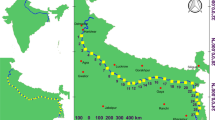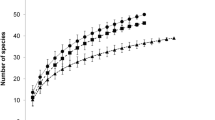Abstract
Bio-indicators are extremely useful for quickly assessing the true condition of a rapidly deteriorating freshwater environment at a low cost. Global research has shown that the spider (Arachnida: Araneae) is a well-known taxon with bio-indicator potential. Present study was performed to find out if any spider species could be used as a bio-indicator of undisturbed habitat for Gangetic riparian zone. For the study, total 27 sites were selected along the Ganga River’s banks, with an average distance of 75 kms between each site. Based on disturbance ratings, the sampling sites were divided into five groups: very low disturbed sites, low disturbed sites, moderately disturbed sites, highly disturbed sites and very highly disturbed sites. The non-parametric analysis of similarities (ANOSIM) test and non-parametric permutational multivariate analysis of variance (PERMANOVA) were used to understand similarities of species composition between these groups. The redundancy analysis (RDA) was performed to investigate the relationship between spider distribution and habitat disturbance. The indicator value (IndVal) method was used to find out significant bio-indicator spider species for habitat disturbance. The study found that the agriculture, human occupation, manmade embankment, and sand mining were the most effective combination of disturbance that affects spider assemblage and eight species can be used as indicator of very low disturbed sites and one species can be used as indicator of low disturbed sites.




Similar content being viewed by others
References
Abellán P, Sánchez-Fernández D, Velasco J, Millán A (2005) Assessing conservation priorities for insects: status of water beetles in southeast Spain. Biol Cons 121:79–90. https://doi.org/10.1016/j.biocon.2004.04.011
Ali ZSK, Johnson JA, Hussain SA et al (2019) Study area and sampling strategy. In: Johnson JA, Hussain SA, Badola R (eds) Biodiversity profile of the Ganga river. Wildlife Institute of India, Dehradun, pp 24–61
Anderson MJ (2001) A new method for non-parametric multivariate analysis of variance. Austral Ecol 26:32–46. https://doi.org/10.1111/j.1442-9993.2001.01070.pp.x
Barton K (2020) MuMIn: multi model inference. R Package Version 1(43):17
Benhadi-Marín J, Pereira JA, Sousa JP, Santos SAP (2019) Distribution of the spider community in the olive grove agroecosystem (Portugal): potential bioindicators. Agr Forest Entomol 22:10–19. https://doi.org/10.1111/afe.12352
Borchard F, Buchholz S, Helbing F, Fartmann T (2014) Carabid beetles and spiders as bioindicators for the evaluation of montane heathland restoration on former spruce forests. Biol Cons 178:185–192. https://doi.org/10.1016/j.biocon.2014.08.006
Cardoso P, Pekár S, Jocqué R, Coddington JA (2011) Global patterns of guild composition and functional diversity of spiders. PLoS One 6:e21710. https://doi.org/10.1371/journal.pone.0021710
Chowdhury MZI, Turin TC (2020) Variable selection strategies and its importance in clinical prediction modelling. Fam Med Com Health 8:e000262. https://doi.org/10.1136/fmch-2019-000262
Churchill TB, Arthur JM (1999) Measuring spider richness: effects of different sampling methods and spatial and temporal scales. J Insect Conserv 3:287–295. https://doi.org/10.1023/a:1009638706789
Clarke KR (1993) Non-parametric multivariate analyses of changes in community structure. Austral Ecol 18:117–143. https://doi.org/10.1111/j.1442-9993.1993.tb00438.x
Coddington JA, Young LH, Coyle FA (1996) Estimating spider species richness in a southern Appalachian cove hardwood forest. J Arachnol 24:111–128
Collen B, Whitton F, Dyer EE et al (2014) Global patterns of freshwater species diversity, threat and endemism. Glob Ecol Biogeogr 23:40–51. https://doi.org/10.1111/geb.12096
Conti E, Costa G, Liberatori G et al (2018) Ariadna spiders as bioindicator of heavy elements contamination in the Central Namib Desert. Ecol Ind 95:663–672. https://doi.org/10.1016/j.ecolind.2018.08.014
da Rosa MG, Brescovit AD, Baretta CRDM et al (2019) Diversity of soil spiders in land use and management systems in Santa Catarina. Brazil Biota Neotrop. https://doi.org/10.1590/1676-0611-bn-2018-0619
Datry T, Melo AS, Moya N et al (2016) Metacommunity patterns across three neotropical catchments with varying environmental harshness. Freshw Biol 61:277–292. https://doi.org/10.1111/fwb.12702
de Jesús-Crespo, Ramírez A (2011) Effects of urbanization on stream physicochemistry and macroinvertebrate assemblages in a tropical urban watershed in Puerto Rico. J N Am Benthol Soc 30:739–750. https://doi.org/10.1899/10-081.1
Dey S, Choudhary SK, Dey S et al (2019) Identifying potential causes of fish declines through local ecological knowledge of fishers in the Ganga river, eastern Bihar, India. Fish Manag Ecol 27:140–154. https://doi.org/10.1111/fme.12390
Dudgeon D, Arthington AH, Gessner MO et al (2005) Freshwater biodiversity: importance, threats, status and conservation challenges. Biol Rev 81:163. https://doi.org/10.1017/s1464793105006950
Dufrêne M, Legendre P (1997) Species assemblages and indicator species:the need for a flexible asymmetrical approach. Ecol Monogr 67:345–366. https://doi.org/10.1890/0012-9615(1997)067[0345:saaist]2.0.co;2
Gezie A, Anteneh W, Dejen E, Mereta ST (2017) Effects of human-induced environmental changes on benthic macroinvertebrate assemblages of wetlands in Lake Tana Watershed Northwest Ethiopia. Environ Monit Assess 189(4):152. https://doi.org/10.1007/s10661-017-5853-2
Hansson SV, Høye TT, Bach L et al (2019) Spiders as biomonitors of metal pollution at Arctic mine sites: the case of the Black Angel Pb-Zn-mine, Maarmorilik West Greenland. Ecol Ind 106:105489. https://doi.org/10.1016/j.ecolind.2019.105489
Jain CK, Singh S (2020) Impact of climate change on the hydrological dynamics of River Ganga, India. J Water Clim Change 11:274–290. https://doi.org/10.2166/wcc.2018.029
Jenkins DW (1971) Global biological monitoring. In: Matthews WH, Smith FE, Goldberg ED (eds) Man’s impact on terrestrial and oceanic ecosystems. The Colonial Press, New York, pp 351–370
Kaltsas D, Panayiotou E, Kougioumoutzis K, Chatzaki M (2019) Overgrazed shrublands support high taxonomic, functional and temporal diversity of Mediterranean ground spider assemblages. Ecol Ind 103:599–609. https://doi.org/10.1016/j.ecolind.2019.04.024
Kamboj N, Kamboj V (2019) Riverbed mining as a threat to in-stream agricultural floodplain and biodiversity of Ganges River, India. In: Kumar V, Kumar R, Singh J et al (eds) Contaminants in agriculture and environment: health risks and remediation, vol 1. Agro Environ Media, Haridwar, pp 250–263
Košulič O, Michalko R, Hula V (2016) Impact of canopy openness on spider communities: implications for conservation management of formerly coppiced oak forests. PLoS One 11:e0148585. https://doi.org/10.1371/journal.pone.0148585
Lehmitz R, Haase H, Otte V, Russell D (2020) Bioindication in peatlands by means of multi-taxa indicators (Oribatida, Araneae, Carabidae, Vegetation). Ecol Ind 109:105837. https://doi.org/10.1016/j.ecolind.2019.105837
Lencinas MV, Kreps G, Soler R et al (2015) Neochelanops michaelseni (Pseudoscorpiones: Chernetidae) as a potential bioindicator in managed and unmanaged Nothofagus forests of Tierra del Fuego. J Arachnol 43:406–412. https://doi.org/10.1636/0161-8202-43.3.406
Mader V, Birkhofer K, Fiedler D et al (2016) Land use at different spatial scales alters the functional role of web-building spiders in arthropod food webs. Agric Ecosyst Environ 219:152–162. https://doi.org/10.1016/j.agee.2015.12.017
Mazzia C, Pasquet A, Caro G et al (2015) The impact of management strategies in apple orchards on the structural and functional diversity of epigeal spiders. Ecotoxicology 24:616–625. https://doi.org/10.1007/s10646-014-1409-1
McGeogh MA (2007) The selection, testing and application of terrestrial insects as bioindicators. Biol Rev 73:181–201. https://doi.org/10.1111/j.1469-185x.1997.tb00029.x
Miyazono S, Taylor CM (2013) Effects of habitat size and isolation on species immigration-extinction dynamics and community nestedness in a desert river system. Freshw Biol 58:1303–1312. https://doi.org/10.1111/fwb.12127
Oksanen J, Guillaume Blanchet F, Friendly M, Kindt R, Legendre P, McGlinn D, Minchin PR, O'Hara RB, Simpson GL, Solymos P, Stevens MHH, Szoecs H, Wagner H (2019) Vegan: community ecology package. R package version 2.5-6.
Paudel S, Koprowski JL (2020) Factors affecting the persistence of endangered Ganges River dolphins (Platanista gangetica gangetica). Ecol Evol 10:3138–3148. https://doi.org/10.1002/ece3.6102
Pearce JL, Venier LA (2006) The use of ground beetles (Coleoptera: Carabidae) and spiders (Araneae) as bioindicators of sustainable forest management: a review. Ecol Ind 6:780–793. https://doi.org/10.1016/j.ecolind.2005.03.005
Peri PL, Bahamonde HA, Lencinas MV et al (2016) A review of silvopastoral systems in native forests of Nothofagus antarctica in southern Patagonia, Argentina. Agrofor Syst 90:933–960. https://doi.org/10.1007/s10457-016-9890-6
Pham BT, Nguyen-Thoi T, Ly H-B et al (2020) Extreme learning machine based prediction of soil shear strength: a sensitivity analysis using monte carlo simulations and feature backward elimination. Sustainability 12:2339. https://doi.org/10.3390/su12062339
R Core Team (2020) R: A language and environment for statistical computing. R Foundation for Statistical Computing, Vienna
Rachwał M, Rybak J, Rogula-Kozłowska W (2018) Magnetic susceptibility of spider webs as a proxy of airborne metal pollution. Environ Pollut 234:543–551. https://doi.org/10.1016/j.envpol.2017.11.088
Radkova M, Naumova M, Stoichev S et al (2019) Biodiversity of epigeic spiders in conventional potato fields in South-western Bulgaria (Ten Years Later). Cr Acad Bulg Sci 72:1052–1058. https://doi.org/10.7546/CRABS.2019.08.07
Ramírez A, Engman A, Rosas KG et al (2011) Urban impacts on tropical island streams: some key aspects influencing ecosystem response. Urban Ecosyst 15:315–325. https://doi.org/10.1007/s11252-011-0214-3
Reyes-Maldonado R, Sánchez-Ruiz JA et al (2018) Comunidades de arañas ribereñas como indicadores de la condición de los ecosistemas fluviales en la cuenca del Río Piedras de Puerto Rico. Actual Biol 39:1–23
Roberts DW (2019) labdsv: Ordination and multivariate analysis for ecology. R package version 2.0-1.
Rutkowski R, Rybak J, Mach T, Rogula-Kozłowska W (2018) Spider webs in monitoring of air pollution. SHS Web Conf 57:02011. https://doi.org/10.1051/shsconf/20185702011
Santy S, Mujumdar P, Bala G (2020) Potential impacts of climate and land use change on the water quality of Ganga river around the industrialized Kanpur Region. Sci Rep 10:9107. https://doi.org/10.1038/s41598-020-66171-x
Schwerdt L, Elena de Villalobos A, Miles FP (2018) Spiders as potential bioindicators of mountain grasslands health: the Argentine tarantula Grammostola vachoni (Araneae, Theraphosidae). Wildl Res 45:64. https://doi.org/10.1071/wr17071
Siddiqui E, Pandey J (2019) Assessment of heavy metal pollution in water and surface sediment and evaluation of ecological risks associated with sediment contamination in the Ganga river: a basin-scale study. Environ Sci Pollut Res 26:10926–10940. https://doi.org/10.1007/s11356-019-04495-6
Singh R, Singh GS (2019) Climate change impacts on the Ganga river ecosystem services: challenges for the well-being of millions. Clim Change Environ Sustain 7:108. https://doi.org/10.5958/2320-642x.2019.00014.0
Spellerberg IF (1991) Monitoring ecological change. Cambridge University Press, Cambridge
Strayer DL, Dudgeon D (2010) Freshwater biodiversity conservation: recent progress and future challenges. J N Am Benthol Soc 29:344–358. https://doi.org/10.1899/08-171.1
Ulrich W, Gotelli NJ (2007) Null model analysis of species nestedness patterns. Ecology 88:1824–1831. https://doi.org/10.1890/06-1208.1
Valente-Neto F, Martínez BT, Hughes RM et al (2021) Incorporating costs, thresholds and spatial extents for selecting stream bioindicators in an ecotone between two Brazilian biodiversity hotspots. Ecol Ind 127:107761. https://doi.org/10.1016/j.ecolind.2021.107761
Verma K, Pandey J, Siddiqui E (2019) Heavy metal pollution in the ganga river enhances carbon storage relative to flux. Bull Environ Contam Toxicol 104:41–48. https://doi.org/10.1007/s00128-019-02761-4
Vörösmarty CJ, McIntyre PB, Gessner MO et al (2010) Global threats to human water security and river biodiversity. Nature 467:555–561. https://doi.org/10.1038/nature09440
Yang H, Peng Y, Tian J et al (2016) Spiders as excellent experimental models for investigation of heavy metal impacts on the environment: a review. Environ Earth Sci 75:1059. https://doi.org/10.1007/s12665-016-5828-6
Zaimes GN, Iakovoglou V (2020) Assessing riparian areas of greece—an overview. Sustainability 13:309. https://doi.org/10.3390/su13010309
Zina V, Ordeix M, Franco JC et al (2021) Ants as bioindicators of riparian ecological health in Catalonian rivers. Forests 12:625. https://doi.org/10.3390/f12050625
Acknowledgements
Authors are thankful to the National Mission for Clean Ganga, Ministry of Jal Shakti, Department of Water Resources, River development and Ganga Rejuvenation, Government of India for sponsoring the work under the project “Biodiversity conservation and Ganga Rejuvenation” (Grant No. B-02/2015-16/1259/NMCG-WIIPROPOSAL). Authors express gratitude to the Director and Dean, Wildlife Institute of India for their administrative support for the study. Authors are thankful the Environment, Forest and Climate Change Department, Government of Uttar Pradesh; the Department of Environment, Forest and Climate Change, Government of Bihar; the Environment, Forest and Climate Change Department, Government of Jharkhand and the Department of Forests, Government of West Bengal for providing support and necessary facilities.
Author information
Authors and Affiliations
Corresponding author
Additional information
Publisher's Note
Springer Nature remains neutral with regard to jurisdictional claims in published maps and institutional affiliations.
Supplementary Information
Below is the link to the electronic supplementary material.
Rights and permissions
About this article
Cite this article
De, K., Siliwal, M., Uniyal, V.P. et al. Spiders as bio-indicators of habitat disturbance in the riparian zone of the Ganga river: a preliminary study. Trop Ecol 63, 209–215 (2022). https://doi.org/10.1007/s42965-021-00192-z
Received:
Revised:
Accepted:
Published:
Issue Date:
DOI: https://doi.org/10.1007/s42965-021-00192-z




